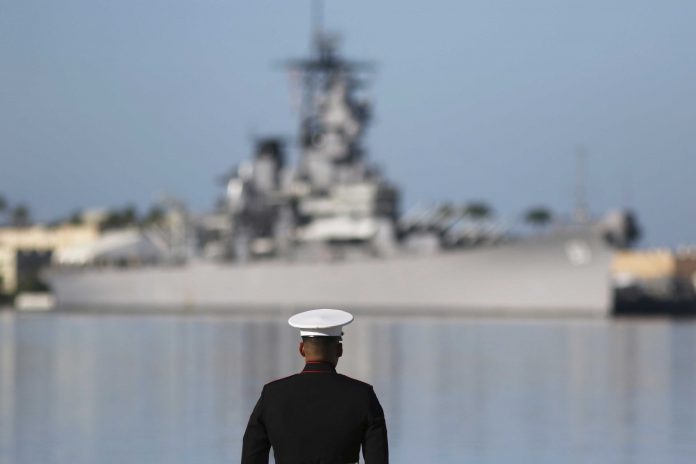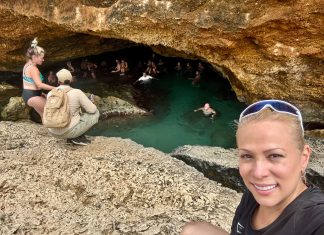When Japanese military leaders climbed aboard the USS Missouri in Tokyo Bay on Sept. 2, 1945, the battleship was packed with U.S. sailors eager to see the end of World War II.
On Wednesday, the 75th anniversary of the surrender, some of those same men who served the United States weren’t able to return to the Missouri in Hawaii’s Pearl Harbor because of the world’s new war against the coronavirus.
The commemoration initially was supposed to be a blockbuster event with parades through Waikiki, movie premieres, galas and thousands of people honoring the veterans, some who may be marking the historic milestone for the last time.
Because of the threat of the virus, the ceremony was scaled down to about 50 people who gathered on the ship that hosted the surrender in 1945, all local veterans and government officials.
Defense Secretary Mark Esper said he was honored to “commemorate and reflect on the sacrifices and victories of our service members and allies who helped fight for and secure peace.”
He ended his keynote address by building a case for a strong military for the future.
“We honor the legacy of those who came before us and recommit ourselves to defending today’s international rules and norms so that the road is safer and is better for generations yet to come,” Esper said. “The United States’ commitment to the role today is the same one we made to the freedom-loving people of the world in 1941 — that we will remain ready to fight any foe and defend any friend.”
Organizers limited the ceremony less than two weeks before the anniversary because of a surge in coronavirus cases in Hawaii and other parts of the nation. That left dozens of veterans in their 90s or beyond giving what could be their final salute from afar.
Jerry Pedersen, 95, was a U.S. Marine when he witnessed the end of World War II on the deck of the Missouri. On the 75th anniversary, Pedersen and his surviving comrades who live on the mainland watched a livestream of the event from their homes instead of seeing it in person on the ship as they had planned.
“Well, I was very disappointed, yes. I was hoping to maybe see a friend or two,” he said. “I just want to share with at least my family and a couple of other folks some of the feelings that I was going to express when I got there.”
Those feelings are complicated, said Pedersen, who dedicated his life to peace after the war ended.
“War must not happen again,” he said, recalling the words uttered by Gen. Douglas MacArthur on the day the Japanese surrendered. But “we’re still oscillating on many of the things that are necessary to bring us peace.”
Pedersen wore a blue Marine uniform recently sent to him for the ceremony while he watched the livestreamed ceremony at his son’s house in rural West Sacramento, California. He and his three adult children, their spouses and some grandchildren gathered around a laptop set up on a dining table. The family clapped and hooted when his name was called; Pedersen smiled and gave a fist pump.
“For me, it was the end of the killing, the war that had taken millions of soldiers and many, many, many millions of civilians in wars in Europe and finally in the Pacific that came to an end that day. And we were celebrating,” he told The Associated Press as he watched the screen.
“I had the feeling that day. I made a pact with myself that I’m going to be a peacemaker in my life,” said Pedersen, who went to college after the war, got his doctorate and became a minister.
The U.S. entered the war after Japanese warplanes attacked Pearl Harbor on Dec. 7, 1941.
“The clouds of war were gathering all around the United States, and the world for that matter,” said Daniel Martinez, Pearl Harbor National Memorial chief historian. “The United States had claimed neutrality. And that neutrality ended on the morning of December 7th, when Japanese forces … launched an all-out assault on the island of Oahu.”
The result was thousands of dead and wounded, about half of which died on the USS Arizona, which still sits submerged in Pearl Harbor next to the USS Missouri Memorial, a floating museum.
Four years later, after massive losses on both sides that included the dropping of atomic bombs on Hiroshima and Nagasaki, the Japanese indicated they would surrender on Aug. 15, then met with Allied forces aboard the Missouri on Sept. 2 to sign the Instrument of Surrender.
“The jubilation of the country was convulsive,” Martinez said. “Pictures that you see in Manhattan, pictures here in Honolulu, which had an incredible celebration of peace. Young men and young women knowing they would not be risking their lives out there in that war.”

















